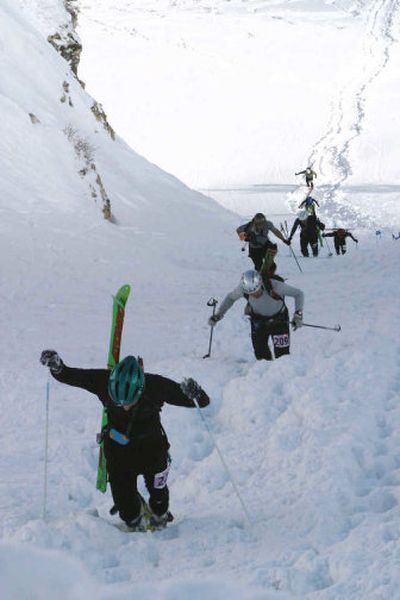Wasatch PowderKeg tests body, skill, mind

SALT LAKE CITY — It’s not enough that competitors in Utah’s toughest ski mountaineering race have to climb up, traverse and ski down thousands of vertical feet of dizzying-steep powder and torso-devouring moguls.
They must also be prepared for avalanches.
Entrants in the Wasatch PowderKeg on March 18 were required to carry an avalanche beacon, shovel and probe.
Despite a small mix-up at the starting line — an avalanche bomb went off seconds before the starting gun was fired — this year’s maximum field of 140 participants stuck pretty much to a course altered slightly to avoid the cornices and wind-loaded slopes created earlier by a storm.
The course is patrolled to minimize avalanche dangers, but organizers say being prepared for the worst is what it takes to excel at ski mountaineering racing — and any winter backcountry adventure in the mountains. They hope the race shows that backcountry travel, even at breakneck speeds, can be safe with careful planning.
“The difficulty is finding a course that’s safe, and safe in all sorts of changing weather conditions,” said Brad Barlage, 32, of Salt Lake City, who raced it two years ago. Barlage works for Salt Lake City-based Black Diamond Equipment, which sponsors the PowderKeg.
“It’s not a race for the first-time skier,” said Katie Cavicchio, the race’s spokeswoman.
Expert skiers would be wise to think twice about entering, too.
Covering 8.4 miles, racers start out from Alta ski resort at 7 a.m., make their way up and over one canyon north to Solitude and wind up at Brighton.
Competitors in the hardest division climb a total of 5,400 vertical feet up several peaks, traverse ridge lines nearly 11,000 feet high and ski four downhill runs that dish out everything from groomed ski resort trails to narrow, powder-filled chutes.
The men’s record is 1 hour, 33 minutes, 8 seconds, set last year by Florent Perrier of France. The women’s record, also set last year, is 1:56:07, by Gloriana Pellissier of Italy.
“You’ve got to be good at a lot things to do well in this race,” said Cavicchio, 28, of Salt Lake City, who competed last year.
“The course goes out of bounds, and anytime you go out of bounds you really need to have a beacon, a shovel and a probe,” said Colleen Graham Nipkow, of Black Diamond Equipment. “That’s what people should be doing anytime they travel in the backcountry in winter.”
Participants also need to bring along a closet-full of winter gear, which they change almost constantly to match the conditions.
At the PowderKeg, some ascents are gentle enough they can be covered with climbing skins — long strips of tough, snow-gripping fabric stuck to the bottoms of skis that allow skiers to shuffle uphill. One climb, however, is so steep that the skis can’t be worn, and racers must kick-step their way up. Downhills can be done any style.
Racers must also bring their own food, water and enough clothing for conditions that can range from mild in the valleys to severe up high.
Ski mountaineering races are a relatively new trend in the United States, although they are popular enough in Europe to support a World Cup circuit and hefty prize purses. The PowderKeg is one of eight races sanctioned by the U.S. Ski Mountaineering Association this year, with proceeds supporting avalanche education.
Andrew McLean, who organized the first PowderKeg four years ago, remembers a climb that was so steep one year that a rope was anchored on it, so racers could pull themselves along hand-over-hand.
Expert skiers who weren’t as ambitious entered the “recreation” division, covering 5.8 miles, with about 3,500 feet of climb and descent.
The reward for finishing either the long or shorter courses: A T-shirt, a pair of new socks, a grab bag and lunch. Category winners also receive a hand-thrown ceramic mug and merchandise from race sponsors.